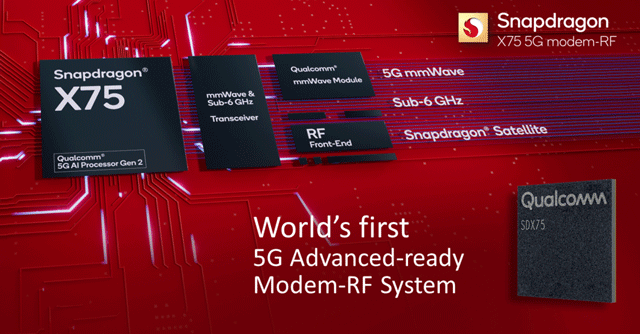
Qualcomm launches 6th gen 5G modem, to be available in devices by end-2023


US-based chipmaker Qualcomm on Wednesday unveiled its new, 6th generation 5G radio frequency modem, called Snapdragon X75. The chip comes a year after the launch of the Snapdragon X70 5G RF modem in February last year, with the latter available commercially in devices powered by its flagship system-on-a-chip (SoC) for mobile phones, the Snapdragon 8 Gen 2. The company confirmed that the new 5G modem will be available in commercial devices that are launched in the second half of this year.
The key new feature in the Snapdragon X75 5G modem is support for 5G-Advanced (5G-A), a network standard that will offer an evolution over what standard 5G connectivity will offer. 5G-A will offer increased bandwidth and lower latencies, which, according to industry experts, will offer a host of new use cases for consumers and businesses.
According to Qualcomm, capability improvements in the Snapdragon X75 modem, over the Snapdragon X70, include a second-generation artificial intelligence (AI) processor, which will offer 2.5x better AI performance than the Snapdragon X65 chip powering the Snapdragon 8 Gen 1 SoC. It also has a second generation 5G AI suite, which the company claims will bring a “world’s first sensor-assisted millimeter-wave beam management” — a feature that can improve network bandwidth and latency on devices that feature this chip.

AI performance in a network modem is used to optimise connectivity based on the available network, and increase available bandwidth and manage latencies to improve use cases such as live gaming and live video streaming for consumers, and faster private networks for industrial use cases among industries such as factory floors.
The Snapdragon X75 also comes with a 4th generation power efficiency chip, which will reduce power consumption in devices. The company further added that the new 5G modem is its first to support ‘10-carrier aggregation’. To be sure, carrier aggregation refers to the ability of a telecommunications modem chip to combine multiple frequency bands when connecting to a network, therefore improving the end-user network bandwidth on offer.
A higher network bandwidth availability equates to users — and smart devices — being able to offer more use cases, such as a higher number of devices connecting simultaneously to a network, lower latency communications across smart devices, and enterprise use cases such as faster network connectivity for cars embedded with a respective chip.

The Snapdragon X75 modem also supports Qualcomm's Snapdragon Satellite chip, unveiled in January this year. Flagship smartphones based on SoCs featuring this modem will thus get satellite connectivity as well. To be sure, a market note from October last year by Jeff Pu, analyst at Hong Kong-based Haitong International Securities, said that Snapdragon X75 will be used in Apple's iPhone 15 series expected to launch later this year.
In a blog post published in September last year, Alex Sinclair, chief technology officer of global telecommunications industry body GSMA said that the key improvements that 5G-A will offer include “improving speed, maximising coverage, enhancing mobility and power efficiency.”
“5G-Advanced also extends 5G to all connected devices virtually, which supports a new generation of business opportunities in areas such as smart mobility, industrial automation, metaverse and extended reality (XR) – blurring the lines between physical and digital worlds with virtual reality (VR) and augmented reality (AR) for consumers and workforces,” he added.

Qualcomm also unveiled a second 5G RF modem, Snapdragon X72, which the company said will offer multi-gigabit upload and download bandwidth, and is specifically geared towards mainstream smartphones.
